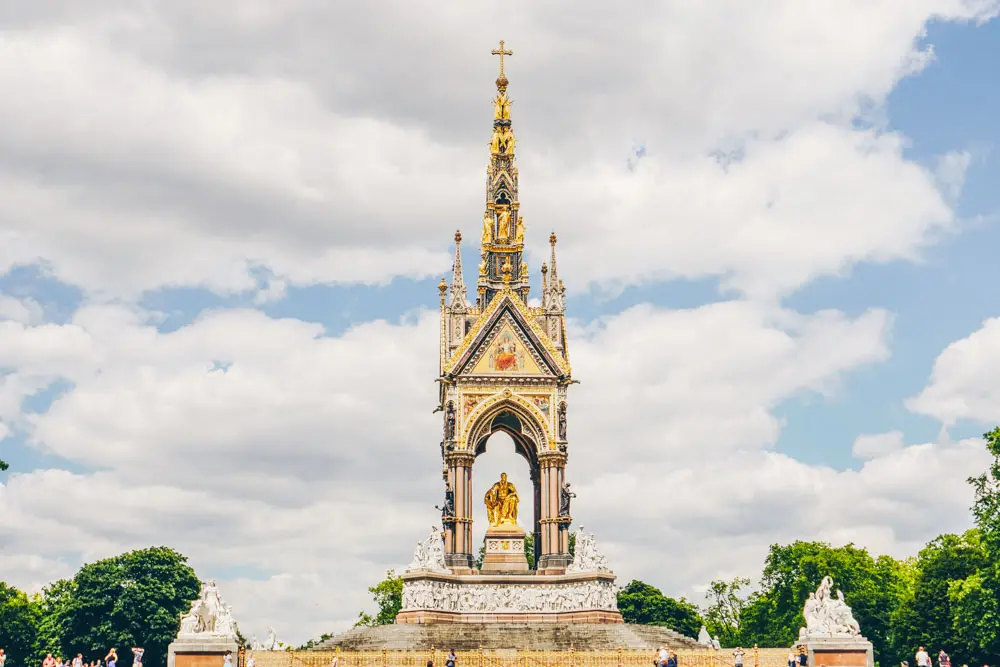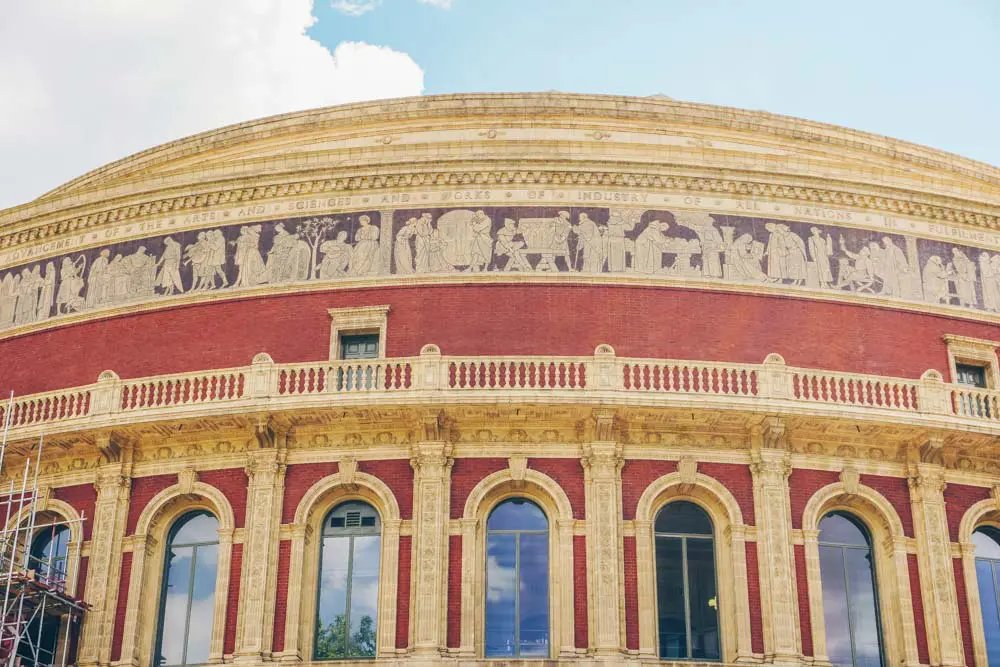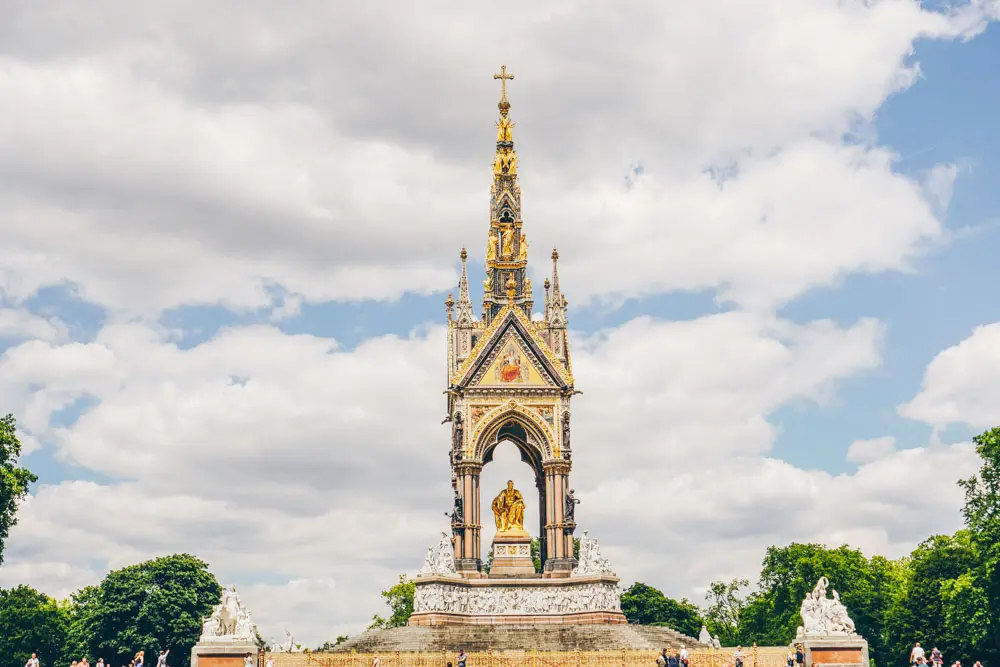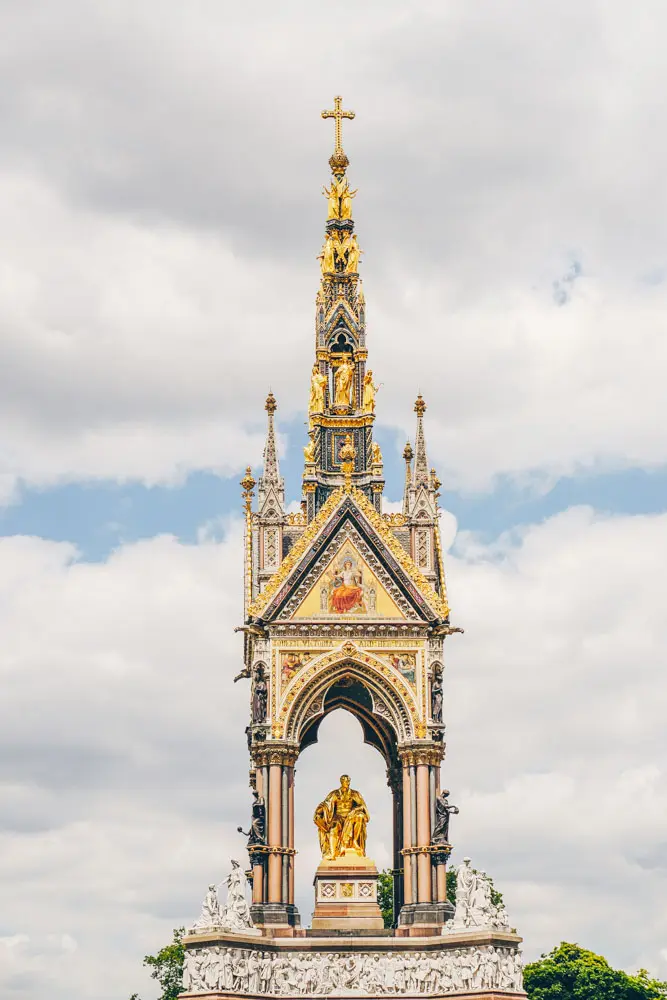Strolling through Kensington Gardens, it’s impossible to miss the imposing structure of the Albert Memorial, gilt glistening against stone and sky. But what is really going on with its intricate design? And who was Albert anyway?
Like many things in London, it’s easy to stop for a moment to admire the intricate work and then move on without giving it much more thought.
If I’m honest, although I’ve walked past the memorial countless times, it was only on my last visit to Kensington that I really stopped to pay attention.
Why did Queen Victoria choose here, on the edge of the gardens to memorialise her late husband? What did all the figures and symbols signify?
It was a pandora’s box of questions that led me to dig a little deeper into the history of the memorial.
Want to know more? Here’s what you need to know about the Albert Memorial.
History of the Albert Memorial

Unveiled in 1872, 11 years after Prince Albert’s death of typhoid in 1861, The Albert Memorial is just one of many (and I mean many) tributes to the late prince consort dotted around London.
Its full title is actually the Prince Consort National Memorial but with the exception of a few people, you’ll be met with blank stares should you call it by that name, so Albert Memorial it is.
Sitting across from the Royal Albert Hall, it commemorates the heyday of the Victorian age – embodying the late prince’s interests and passions alongside a celebration of imperial Britain.
As for the location – it was only natural for it to be in close proximity to Royal Albert Hall – a venue that Albert had proposed and planned (it was to be called the Central Hall of Arts and Sciences) though never lived to see built.

It had actually been suggested that a statue be built in Hyde Park to commemorate Albert’s work for the Great Exhibition during his lifetime – an idea he didn’t take to at all.
In fact, biographer Theodore Martin, in The Life of His Royal Highness The Prince Consort, vol. 11, 1876 notes Albert’s precise response:
‘I can say, with perfect absence of humbug, that I would much rather not be made the prominent feature of such a monument, as it would both disturb my quiet rides in Rotten Row to see my own face staring at me, and if (as is very likely) it became an artistic monstrosity, like most of our monuments, it would upset my equanimity to be permanently ridiculed and laughed at in effigy.’
Guess he wasn’t there to protest the idea after his death though.
The memorial was a long time coming, though it had been planned almost immediately after Albert died.
In 1862 the then Lord Mayor asked seven leading architects to advise on potential structures, and Sir George Gilbert Scott’s, the only Gothic-style submission, was chosen as the winning design.
There were many delays between Scott’s design being chosen and the official opening of the memorial in 1872 – mostly due to the unforeseen expense of building the elaborate memorial.
By the time it opened, over £120,000 had been spent on the structure – tantamount to £10 million in today’s money.
Still, it was well received, and has now stood for a century and a half bringing imposing grandeur to its corner of Kensington Gardens.
Looking Closer at the Albert Memorial: Design & Influences

Perhaps more than any other structure in London, the Albert Memorial showcases the very best of the high Victorian gothic style.
It was greatly influenced by the series of 12 Eleanor Crosses King Edward I had erected in the 13th century to commemorate his late wife Eleanor of Castile. Charing Cross was one, while others could be found in destinations across the east of England ranging from Lincoln down to Charing.
Glance at any of the three surviving crosses and the similarities are clear to see – but Gilbert Scott’s Victorian gothic style far surpasses the crosses in scale and grandeur.
Prince Albert
The memorial depicts Prince Albert sitting down, holding a catalogue of the Great Exhibition (which had been held in Hyde Park in 1851) in his hand. Albert had inspired and helped create the exhibition, which ended up being a roaring success.
He sits under a canopy decorated with allegorical figures of the arts – another reference to his enduring passion for artistic expression.
Four Continents
Perched on each outer corner of the monument’s periphery, you’ll find marble figures representing four of the continents – Europe, Asia, Africa and The Americas. The Americas are represented by a bison, Europe a bull, Africa by a camel and Asia by an elephant.
Parnassus Frieze
Set at the base of the memorial, the Parnassus Frieze incorporates the figures of renowned artists – amongst them poets, musicians, painters and poets. Prince Albert had been an ardent lover and supporter of the arts, so it felt fitting to incorporate this into the monument.
The Christian Virtues & Angels
Two tiers of golden angels sit at the top of the memorial, underneath which are depictions of the Christian and moral virtues, also in gold. It’s difficult to identify the virtues individually, but collectively the overall effect is impressive.
Industrial Arts
Set in a square set inwards from the periphery of the monument, the four statues to the industrial arts represent Victorian Britain at the height of production. The four, which illustrate agriculture, manufacturing, commerce and engineering sit in close proximity to the prince himself. Each was created by a different sculptor, though they had to align with Scott’s plan for the memorial.
Who Was Prince Albert?

Ever hear people say the British royal family is German? Well that’s because of Albert – Prince Albert of Saxe-Coburg and Gotha to use his full title.
The man who would go on to sit at the queen’s side through one of the most formative years of British history was born near Coburg in Germany, 1819. Full name: Franz August Karl Albert Emanuel.
He was born at a time when Royalty meant something much different to the meaning it holds today. Divide between rich and poor had much more potency and the idea of a spare prince marrying a commoner, almost unthinkable.
For the European monarchs this created a problem – there wasn’t enough of that sweet royal blood to maintain a diverse gene pool. In 1840 Albert married his cousin, Queen of England, Victoria.
What we might assume was an unhappy, incestuous union turned out to just be an incestuous one. The pair were very content. Victoria even wrote to uncle Leopold to thank him for arranging the marriage saying: “He [Albert] possesses every quality that could be desired to render me perfectly happy.”
At first Albert was not taken to kindly by the British public. Things began to change after he kept a cool head during a botched assassination attempt on the Queen’s life. He went on to champion educational reform in Britain, winning support of the working class.
He also dedicated his time to eradicating slavery worldwide. Owning slaves was already illegal in the British Empire, but Albert wanted it outlawed in every country, not just the ones his wife ruled.
Prince Albert was also something of a house husband. As Victoria was busy running the country he took charge over the household, helping raise the children. All nine of the little ones in his care made it to adulthood, a significant achievement for anyone – even royalty – in the Victorian era.
Prince Albert died of typhoid in 1816, aged 42. His death devastated Victoria so much that she swore never to wear again any other colour than black, which she did every single day until her death over 40 years later.
Practical Information
Address
Kensington Gardens, London W2 2UH
Getting There
The nearest underground stops are Knightsbridge, South Kensington and Gloucester Road or Lancaster Gate and Queensway on the other side of Hyde Park.
